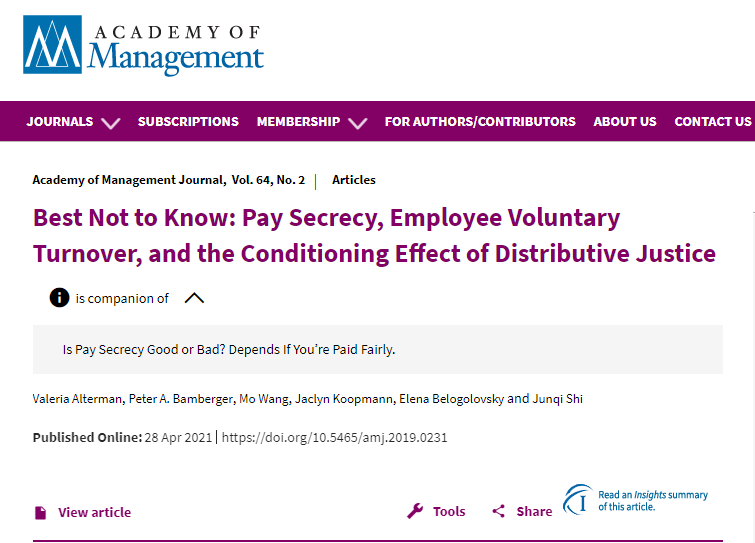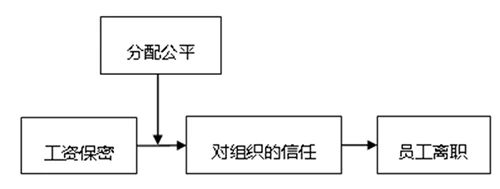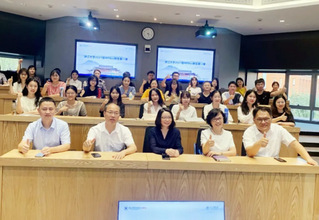“工资保密制”自诞生以来,受到很多企业争相推崇,但与此同时也引发不少人热议。有人说,实行工资保密制的企业,员工的自愿离职率比较低,因为“没有对比就没有伤害”;也有人说,企业对员工的工资越是保密,员工自愿离职率越高,因为当员工不经意间发现公司的薪酬倒挂现象严重时,更容易想要离职跳槽。
日前,浙江大学管理学院领导力与组织管理学系教授施俊琦与国际学者合作的一项研究发现,在工资保密制度对员工自愿离职的影响过程中,“分配公平”发挥着调节作用。也就说,该制度最终影响是好是坏,要看分配是否公平。

浙江大学管理学院领导力与组织管理学系教授施俊琦
研究以“保密工资制与员工自愿离职:分配公平的调节作用(Best Not to Know: Pay Secrecy, Employee Voluntary Turnover, and the Conditional Effect of Distributive Justice)”为题,在国家自然科学基金(批准号:71425004)资助下完成。研究中,施俊琦与合作者基于不确定性管理理论(Uncertainty Management Theory),探讨了组织中工资保密制在个体层面、组织层面的影响和关键边界条件,旨在为组织中人力资源管理实践提供学术依据。2021年4月28日,该研究成果发表于国际顶级期刊《美国管理学会学报》Academy of Management Journal。

发表截图
企业当中的薪酬制度往往与企业所能拥有的人力资本息息相关,但现有研究尚未充分探究企业薪酬发放中有关工资保密制度对于员工自愿离职的影响。
鉴于此,该研究基于不确定性管理理论,考虑了工资保密制的实践情形下,程序公正性较低而不确定性较高的双重特征,提出并探讨了工资保密制对员工离职行为影响的过程中,分配公平的调节作用(见理论模型图1)。

图1 研究理论模型图
通过分析分别收集自个体层面和组织层面的两个样本的数据,研究发现,在个体层面上,当员工感知到的分配公平水平较低时,工资保密制与员工对组织的信任之间的关系显著为正;而当员工感知到的分配公平水平较高时,工资保密制与员工对组织的信任之间的关系显著为负;而当员工对组织的信任水平较低时,其离职意愿则较高。
在组织层面上,该研究发现组织中工资保密制的实行与离职率在分配公平氛围较高时显著为正,但在分配公平氛围较低时没有显著影响关系。
现有关注组织中工资保密制的研究,大多仅从公平理论的视角出发,论证组织管理中程序公平的重要性。而该研究则更关注工资保密制中的不确定性的因素,深入探讨了该制度对员工感知及其离职的影响,也为组织的管理实践提供了一些有益的启示(如:分配公平氛围的营造水平)。
附:论文摘要
Building on uncertainty management theory, we develop and test a model explicating how and when secrecy in pay communication may affect employee turnover-related outcomes (i.e., employee turnover intentions and firm voluntary turnover rates). Underlying this model is the notion that employees triangulate perceptions of pay secrecy (i.e., a pay-related procedural justice cue that also reflects uncertainty) with their own or others’ perceptions of distributive justice as a basis for assessing organizational trustworthiness, with the latter serving as an important driver of voluntary turnover intentions and behavior. Results of two studies (Study 1 at the individual level and Study 2 at the firm level) indicate that, rather than being universal, the relationship between pay secrecy and turnover is contingent upon perceptions of distributive justice, with turnover intentions (at the individual level via organizational trustworthiness) and voluntary turnover rates (at the firm level) differentially affected by pay secrecy under conditions of higher and lower levels of distributive justice. These findings suggest an important extension to organizational justice theories; namely that, when procedural justice cues are confounded with uncertainty (as they are with pay secrecy), the assumed compounding interaction between procedural and distributive justice cues may be replaced by a more antagonistic interaction.






